Tour
The Shure SE420s' ear buds are one part sparkling gray and one part slightly-darker sparkling gray. The ear buds themselves have nozzles that protrude at an angle. The tips of these nozzles are open to the air, but there is a guard at the very bottom. The headphones are meant to be worn with the cord around the back of the ear, as indicated by the 'L' and 'R' markings on the back of each ear bud.

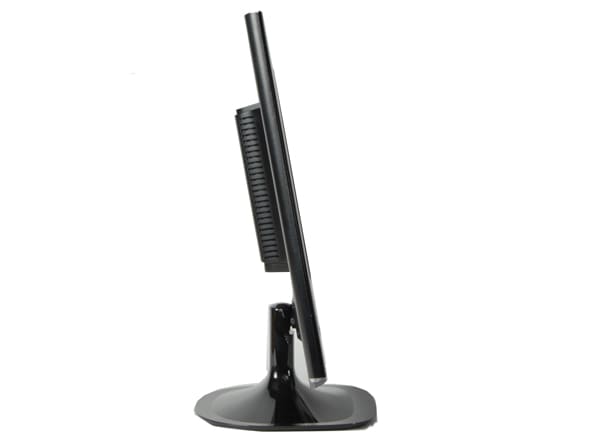
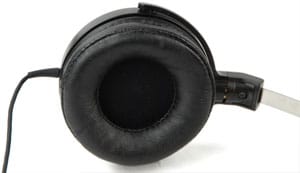
The padding is slightly triangular, with more padding toward the outside edge and less towards the inside.
The cord is dark gray, and truncates at a heavy-duty junction where the two channels meet. This split has a 1/8-inch plug, which you can connect to a media player or the included extension cord for additional length.

In the Box
{{section_header}}{{section.name}}{{/section_header}}
In the box is a treasure trove of sleeves (4 sets of foams in three sizes, 3 sets of soft plastic in three sizes, and a set of triple-flanged). You'll also find the headphones, their extension cord, an optional in-line volume switch, a 1/4-inch adapter, an airplane adapter, and a firm-covered carrying case.
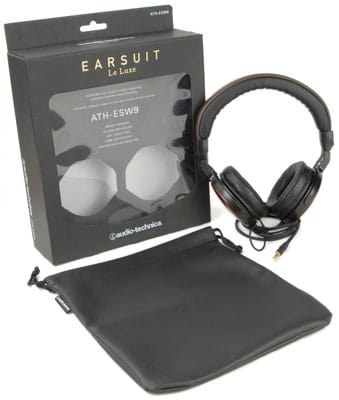
Durability
{{section_header}}{{section.name}}{{/section_header}}
In terms of durability, the Shure SE420s seem to be in good shape. The cord is thick, has robust junctions with the ear buds and plug, and seems to be well constructed overall. The one, somewhat minor issue we found was with the neck split slide-adjuster. As on the SE210s, the slider ripped quite easily. The cord guards tend to whiten with stress, which might not bode well for durability. Another issue is the open nozzles. The nozzles don't have a guard at their front, which exposes their interior to all kinds of gross stuff. While there's a cleaning tool included, it won't reach far into the nozzle. This means the bottom of the nozzle could accrue rogue ear wax and dust which, over time, will both decrease audio quality and just be really gross in general.
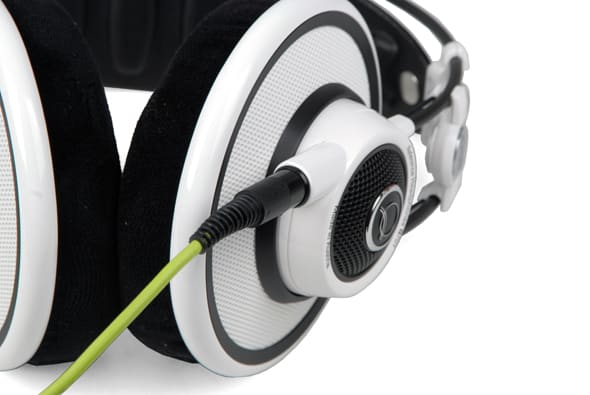
These issues aside, however, these headphones look and feel quite rugged. You don't feel like you need to treat the SE420s with kid gloves, which is definitely a good attribute. As long as you watch for the issues mentioned above, then your Shure SE420s should stay healthy.
Aesthetics
{{section_header}}{{section.name}}{{/section_header}}
In-ear headphones don't have a lot of space to work with. Even a really great design is likely to go unnoticed due to their innocuous size. This being said, the Shure SE420s look nice. These headphones have the typical Shure bent nozzle, which means you either have to loop the cord around your ears or the headphones will stick straight out of your ears (which isn't particularly flattering). The headphones themselves look fine enough, however. They're different from the iPod headphones out there, but they just aren't particularly attractive or unattractive. Like the Shure SE210s, these might not look overly fancy, but they look nice enough.
Summary
{{section_header}}{{section.name}}{{/section_header}}

The SE420s are a set of in-ear headphones from Shure, available for $200. Like other Shure headphones, the SE420s have angled nozzles, which make them look a bit different than other in-ears. If you like to wear your headphones' cord looped around the back of your ear, the SE420s were built for you. Otherwise the fit might be a bit awkward. These headphones are very short without their extension cord, which is great for joggers or anyone else who might wear a media player in an arm band.
Frequency Response
{{section_header}}{{section.name}}{{/section_header}}
The Shure SE420s had a pretty good frequency response result. As you can see, these headphones put some emphasis on the bass frequencies but trail off towards the higher end. The lines dip a bit below the lower limit here, but overall the line progressed evenly. If there were any sharp peaks or long furloughs far outside the limits, then it would have been an issue. As it is, the Shure SE420 wasn't perfect, but still performed pretty well.
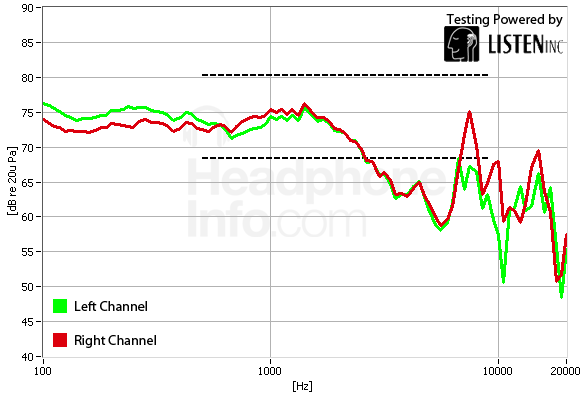
The SE420s' managed to score ever so slightly above average here compared to the comparison headphones. As you can see, the SE420s managed to perform better than the SE210s, although the general shape of the curve was about the same. The MM 50 iPs scored a bit better, because they barely strayed outside the scoring limits at all (the bass was a bit loud, but we don't score on the extreme low or high end). The other set of headphones that did better than the SE420s was the 6isolators, which had a very even keel to their frequency response. This is great for music purists who want a faithful representation of their music. Again, overall a good showing from the SE420s, but not particularly outstanding.
Distortion
{{section_header}}{{section.name}}{{/section_header}}
While it wasn't terrible, the Shure SE420s did show a bit of distortion. Most of it was in very low amounts across the whole spectrum, but it did have a small bump around the 1kHz mark. Overall, it stayed below 1% the entire time, which means it'll be less noticeable than a brief spike in distortion.
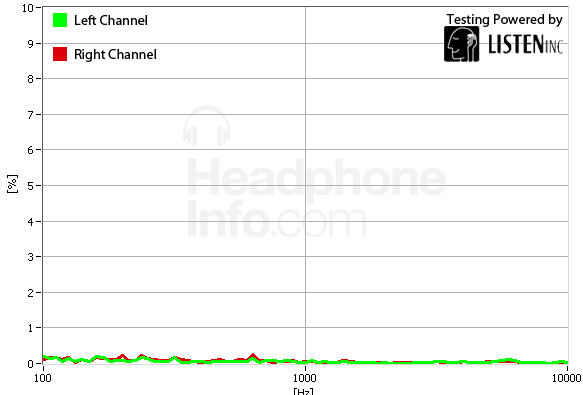
The only set of headphones the SE420 had less distortion than were the Audio-Technica ATH-ANC3s. If you check out the graph you can see why. The other headphones might be less obvious due to the small increments involved and the minute size of the thumbnails. Most have slightly bumpier lines, but the bumps are brief and, most of the time, involve a lower distortion level than the SE420 at its max.
Tracking
{{section_header}}{{section.name}}{{/section_header}}
The SE420s had great overall tracking. Again, what we look for here are any sharp hikes or plummets. We don't score the far high or low end, which renders those spikes around and after 10kHz moot. The response is very, very flat across virtually the entire stretch, meaning the audio will be very balanced. In the results pictured at here, the right channel was about 2dB louder virtually the entire way. This imbalance is so small it's almost insignificant, and could likely just be remedied by adjusting the ear buds.
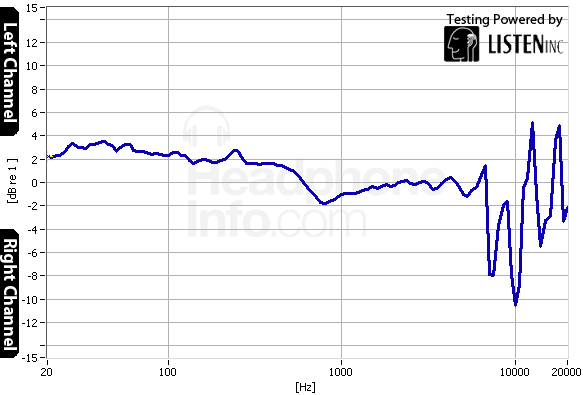
The Shure SE420s had a very flat tracking score. It managed to do better than just about every other set of the comparison headphones. Some of the headphones pictured below have seemingly flatter graphs, but keep in mind that these graphs are normalized: there was probably some brief spike that got flattened out somewhere along the line. Really, though, anything above 8 is really well balanced, to the point where the typical users probably wouldn't notice. The Shure SE420s simply manage to be better than they need to be.
Maximum Usable Volume
{{section_header}}{{section.name}}{{/section_header}}
The headphones were able to squeeze out 122.54dB before the distortion got bad. This garners the SE420s maximum points for this score. Any more than 120dB is dangerous to anyone without pre-existing hearing problems. It can also have adverse affects on your headphones. In the SE420s case, however, anyone who likes it loud will be very pleased.
Isolation
{{section_header}}{{section.name}}{{/section_header}}
The Shure SE420s have an amazing capability to drown out external noise, partially due to their wide selection of sleeves (the bits that stick onto the ear bud to protect it from the nastiness that hides in your ears). We tested out the three types of sleeves and found that, contrary to our initial beliefs, the foam sleeves were able to block out more sound than our previous pick for best isolators, the triple-flange sleeves. This makes sense, because actual ear plugs nowadays are made of foam, not little plastic Christmas trees. To the triple-flanged sleeves' defense, however, they came in a very close second place.
In any case, these foam ear buds were able to block out an impressive amount of noise. Like most in-ears, the majority of this blockage happened towards the higher frequencies, but it did block out an impressive chunk towards the lower end too.
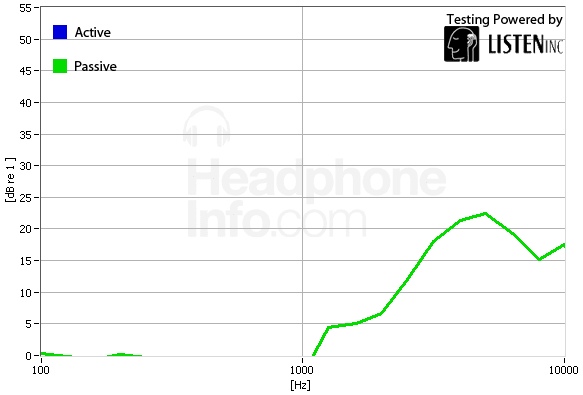
The Shure SE420 is, at the time of this writing, the best set of headphones for isolation. The Etymotic Research 6isolators, one of our first reviews, has finally been dethroned, and active-cancellers out there lie prostrate before its attenuating might. The SE420s are excellent for blocking out sound.
Leakage
{{section_header}}{{section.name}}{{/section_header}}
These headphones barely let out a whisper. You should have no fear of anyone ever hearing your playback. These headphones would be great for hipsters that don't want to continually say they're listening to Chiptunes or La Bouche ironically.
Short-Term Use
{{section_header}}{{section.name}}{{/section_header}}
First of all, we have to give our standard caveat: the people in our office who tried out these headphones, in all likelihood, have heads and ears shaped far differently than yours. We highly recommend you try on these or any headphones for at least a few hours before you decide to keep them.
We're not huge fans of Shure's in-ear headphone design. If you wear them the correct way, the cord has to loop around your ears, which we don't find particularly comfortable. If you invert them 180 degrees so the cord hangs downward, they jut out and away from your ears. Not only does this look a bit silly, but it just felt a bit odd since the cord was falling away from the ear buds at an odd angle. Also, the sleeves aren't particularly comfortable. Other soft plastic sleeves are made out of a thinner material and therefore don't put as much pressure on our ear canals.
Extended Use
{{section_header}}{{section.name}}{{/section_header}}
Once we wore the headphones for a bit, we didn't mind the weird fit quite as much. This increase in overall comfort was diminished somewhat by the thick sleeves causing slight discomfort over time. Overall, they're of average comfort, but if you don't like in-ears you won't like these headphones.
Cable Connectivity
{{section_header}}{{section.name}}{{/section_header}}
The Shure SE420s have a short cord, which is just long enough to reach the media player in your athletic/trendy arm band. With the extension cord, the headphones stretch to almost 5 feet in length, which is above average for in-ear headphones. We like the extra inches, but the SE420s aren't stretching across the room any time soon.
The Shure SE420s also come with two adapters: 1/4-inch and airplane. The 1/4-inch adapter is to make your headphones compatible with a wider range of stereos and amps.

These are the two cords that come in the box. It would've been nice to have a male-to-male connector to form one long cord, but alas, we do not live in such a world.
Customizability
{{section_header}}{{section.name}}{{/section_header}}
The Shure SE420s have a fair bit of customability inherent in the packed-in selection of sleeves. There are three types to choose from: foam, soft plastic, or triple flange. There are two pairs of small-sized foam sleeves, two mediums, and one large. There are small, medium, and large offerings for the soft plastic sleeves, one pair per size. Alas, there's only one pair of triple-flanged sleeves.
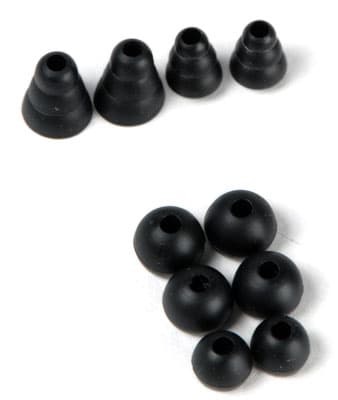
There's also an included accessory, the volume dial attachment. This customization option (obviously) gives you an easier way to control your playback volume. This functionality isn't remarkable, but it's a great inclusion we typically don't see offered.

Portability
{{section_header}}{{section.name}}{{/section_header}}
The Shure SE420s are very portable, despite the thickness of their cord. The reason for this, of course, is due to their ridiculously short length. Since they're just over two feet in length without their extension cord, they have the potential to be more portable than typical in-ear headphones. If you're not using an arm band, then they're slightly less portable compared to other in-ears (the cord is a thicker and longer than average). The headphones do come with a carrying case, but it's not particularly fancy. It doesn't have any pockets or anything inside, which is unfortunate; many in-ear headphones, like the Etymotic Research 6isolators or Audio-Technica ATH-ANC3, have several pouches in their carrying cases for corralling all their sleeves. With the Shures you'll have to be careful, lest you comically spill all 24 individual sleeves every time you open the case.
Maintenance
{{section_header}}{{section.name}}{{/section_header}}
Like other in-ear headphones, there isn't a lot you can do in terms of taking the headphones apart to fix issues. The SE420s will let you take off the sleeves for better cleaning. They also come with a cleaning tool, which is basically a loop of metal in a plastic stick. This is a great inclusion, but the reason it's included is because the headphones' nozzles are totally open to the air. That means that the inside of the nozzle is in constant peril from all the gross stuff in your ears as well as external dust, grime, or tiny insects (in particular look out for ear wigs or the terrifying miniature ear-eating scorpion). Though we realize the open nozzles are why the tool was included, we think the open nozzles themselves create a bit of a maintenance issue where there might not have been one previously. The tool also doesn't reach particularly far down the nozzle because Shure obviously doesn't want you poking anything vital. This does mean, however, that stuff will get buried at the bottom of the nozzle, then laugh at you as your tiny cleaning tool fails to exhume it.
Other Features
{{section_header}}{{section.name}}{{/section_header}}
Battery
The Shure SE420s don't require any batteries. Since fancier headphones can sometimes need batteries, we think those than don't deserve some points. Batteries are a pain to maintain, especially when dead batteries mean you can't listen to your freshly-charged media player. Really, when you're listening to music, the only battery you should have to worry about is that of your media player.
Value
{{section_header}}{{section.name}}{{/section_header}}
The Shure SE420s are a touch expensive, but not absurdly so. For the most part the SE420s have a cost that's proportional to what they offer. If you're looking for a budget option, check out the Shure SE210s, which offer proportionally the same deal but cost less (and therefore offer less). If you're looking for a flat-out deal, check out the Sennheiser MM50 iPs or the Denon AH-C351s, both of which cost a lot less. The MM 50 iP headphones also offer a bit better audio quality and a totally different wear experience. The AH-C351s have a similar short-cord design, but use a lighter cable gauge. They also don't come with as many extras and offer poorer audio quality. If you're a commuter, however, we think the SE420s are a good enough value to merit consideration.
Conclusion
{{section_header}}{{section.name}}{{/section_header}}
The Shure SE420s are a solid pair of headphones. Their frequency response graph wasn't bad, their distortion was fairly low (to the point of not being noticeable unless you were looking for it), and they can isolate better than any other headphones we've reviewed. If you've been getting annoyed at how loud your commute is, or if your desk at work is right near the squeaky air conditioner, the SE420s can offer you the silence you seek. They are great isolators, both for you and those around you. What they aren't, however, is cheap or particularly special-sounding. If you're buying based on your wallet's contents then we'd point you at any of the other five comparison headphones, especially the MM 50 iPs or Denon AH-C351s. The former is a better overall set that can't isolate nearly as well, but retail for half the SE420s' price; the latter is good for what it costs, which isn't a lot. While the SE420s should be taken into consideration if you're looking for in-ears, they're a shoe-in for isolating its users from everything.
Meet the tester
Mark Brezinski works on the Home Team, reviewing refrigerators, minifridges, dishwashers, washing machines, dryers, air conditioners, air purifiers, and fans.
Checking our work.
Our team is here to help you buy the best stuff and love what you own. Our writers, editors, and experts obsess over the products we cover to make sure you're confident and satisfied. Have a different opinion about something we recommend? Email us and we'll compare notes.
Shoot us an email